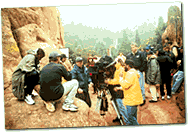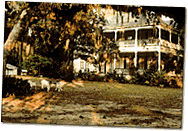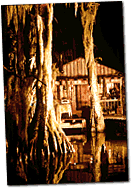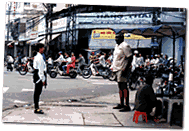TRIP HOP
David Geffner on location shooting
For the last decade, American indie features have been defined by their urban and suburban settings, the films' creators typically drawing strength from the many hometown stories Hollywood has chosen to ignore. Indie efforts like Slacker, Clerks, She's Gotta Have It, The Brothers McMullen, The Unbelievable Truth, and anything by Gregg Araki, all reflect a personalized, "let's shoot a movie in our own backyard" reality that has pushed many low-budget auteurs on to glory at the national level. But increasingly, as American audiences get pounded by grassroots tales from mass-entertainment forms as diverse as the Internet and MTV's "Real World", independents have begun to look to more distant, even exotic locations for their inspiration.
Recent projects like Tony Bui's Three Seasons or Hirotaka Tashiro's Mr. P's Dancing Sushi Bar traveled all the way to Vietnam, where very few American crews have dared to tread, to satisfy their muses. Other films, like Kasi Lemmons' Eve's Bayou, Bart Freundlich's The Myth of Fingerprints, Tim Blake Nelson's Eye of God, Jesse Peretz's First Love, Last Rites, Billy Bob Thornton's Slingblade, and Harmony Korine's Gummo, uncovered pockets of small-town Americana rarely visited on the big screen. And still others took a cue from their big-budget TV cousins, who have been using Canada as a stand-in for the high costs of New York or Chicago for many years. The more rural, offbeat, dangerous, strange, and heretofore unseen locations, the better is the war cry of many indies these days.
The Search
Any good producer will tell you that finding an out-of-town location with friendly locals and a minimum of red tape is half the battle on an indie road shoot. But once the script's in place and the budget's locked down, where and how does the search for those far-off locations really begin?
 |
| Strangeland, photo: Gene Page |
Andrew Saxe, a New York-based location manager for The Myth Of Fingerprints, concurs, adding: "Our script was written with western Maine in mind, so the director knew the area where he wanted to shoot but not the exact site. We hooked up with a Maine-based location scout and just hit the road driving. We eventually settled on this amazing old resort mansion -- the Chandler Estate -- just outside a town called Andover. [The town] was completely unfamiliar with movie shoots, but the locals were really receptive to us. They basically viewed us as a big group of tourists who were in for the off-season, who just happened to take over their town for eight weeks!"
 |
| From Eve's Bayou Photo: Chris Helcermanas-Benge |
 |
| Eve's Bayou, photo: Chris Helcermanas-Benge |
Setting In
As location manager Saxe notes from his experience in western Maine, the goal of an indie shoot is to have minimal impact on a site's environment and people while still solving the many problems that will inevitably crop up miles from a crew's home city. The location manager, not to be confused with a production manager or line producer, is meant to serve as a conduit to the community. He or she straddles a line between the needs of his film and the city -- or more accurately, the town or hamlet -- his crew has descended upon.
"It's a strange paradox," Saxe notes. "In a remote area you're often dealing with people who are not film savvy, and you can make terrific deals. We got this country club to put up our crew for a ridiculously low rate because we were there for two months and the rooms would have been sitting empty. We also had the town's restaurants rotating nights to stay open late and feed our crew. But, by the same token, you can't come into a small town with any sort of belligerence just because you have to get your little movie done. Especially if you're going into people's homes and re-painting or knocking out holes."
 |
| Mr. P's Dancing Sushi Bar |
"The main character in our film is a six-foot four-inch African-American war veteran," the Korean-born producer laughs, "so we couldn't exactly pretend like we were some local news crew doing sound bites in the heart of Ho Chi Minh City. But even though we definitely stood out, racially-speaking, we kept a low profile. Don't create any chaos or problems, and don't impede the local vendors in their business. And giving small amounts of money as tips is a way of life in other parts of the world, and you do what's necessary to get your shots."
When indies travel to foreign countries, particularly those beyond the borders of American diplomacy, like Vietnam, almost anything can happen and usually does. Park had one experience where her team was planted in a rice field trying to get the film's climactic sunset shot, when the local mayor came out and announced that her crew had to leave. No reason was offered. With the weather changing by the minute and a return to Asia strictly off the budget, Park instructed her crew to simply walk slowly off one-by-one with the camera running in a single, static long shot, buying a few precious moments before the sun washed down behind them.
Ironically, for some indie producers the biggest headaches sometimes occur before their crews ever set foot on foreign soil. The Screen Actors Guild, for example, has a hard-nosed policy of not granting waivers for their actors to leave the country on films with budgets under $500,000. "Dealing with SAG was incredibly frustrating," Park continues. "I was getting pressure from our Japanese investors to drop the SAG leads just so we could go shoot in Vietnam. In the end I begged and pleaded and didn't hear until the day before we were to begin shooting that SAG had finally granted us the waiver [to allow the actors to leave the country]. It's a fact producers need to consider if they want to shoot low-budget overseas."
Actors' contracts notwithstanding, most obstacles on long-distance shoots revolve around securing equipment. Many U.S. film rental houses have what are called "hot zones," which preclude bringing their gear into certain specified countries due to political unrest or potential violence against Americans. And, if a support package of camera, lights, and grip equipment goes uninsured, indie producers need to carefully consider their level of risk should things go awry in foreign lands. Additionally, processing negative and screening dailies in an area like Southeast Asia can be difficult so tremendous care must be taken in lead-bagging all camera originals on the marathon ride back home, which can involve multiple plane and baggage changes.
"You learn to be very creative when you're shooting in a place like Vietnam," Park concludes. "I couldn't find a BL-4 anywhere in Southeast Asia, so we had to bring all our equipment with us from L.A. To avoid excess baggage charges, I asked my crew to only travel with carry-on luggage -- that way we could check the equipment through and not pay fees. I told them, 'Are we going to bring extra clothes for going out to dinner, or are we going to get the shots we need?' Everybody pulls together when you're so far away from home."
Film Commissions
On most distant location shoots, the state or county film commission is a producer's first port of call. The relationship is a fairly obvious one -- filmmakers want to get as many free services as possible while the commissions try to bring in as many out-of-state dollars as a given town or city can absorb. Residents of many remote communities often welcome the temporary boom in local business a film crew brings in, and they're often swayed by the excitement and glamour of even the smallest shoots, although they may be a wee bit unprepared for the scope of things to come. Occasionally, the trade-advancing interests of a state's film commission are not always in sync with the environmental or civic concerns of a town's Chamber of Commerce, and filmmakers may need to tread lightly or even select an alternate site. This, however, is often the exception rather than the rule.
The Association of Film Commissioners International (AFCI) and their yearly publication Locations, which coincides with the AFCI's annual trade show, is a fairly vital point of departure for producers seeking out-of-state or country contacts. Also essential is the AFCI's annual listing of its membership -- The Global Passport Directory -- which lists both U.S. and international film commission contacts associated with the organization. At last count the AFCI had representatives from all 50 states as well as 22 countries abroad. But, aside from providing extensive photo files on historical homes and bridges, what is it that film commissions accomplish in real, practical film terms?
"I think the role of the film commission varies from state to state," observes Dana Hanby. "Here in Louisiana they are very aggressive in publicizing the unique beauty of the state but less diligent when it comes to follow-up once filmmakers have arrived. As a location manager, I feel they should bend over backwards when an independent comes in. They should push through all the permitting and act as go-betweens with historical societies, state parks, and local law enforcement. If a levee floods on a site we want to shoot, they should be there, on the spot, to help round up a new location right away."
 |
| 54, photo: Kerry Hayes |
Notes Janice Reid, location librarian of the Ontario Film Development Corporation, "Myself and Eardley Wilmot, a freelance location manager we work with, took the 54 group on a nighttime 'club crawl'. We drove around to at least five or six different spots, calling ahead to make sure there wouldn't be problems at the door getting in. Once we were inside each spot the filmmakers got the grand tour. 54 was sort of the hip project, and everybody wanted to see them shoot here very badly."
At the other end of the spectrum from Ontario's large support structure is the Maine Film Office and assistant director Greg Gadberry, who is one of only two employees charged with running the entire state's film commission. "Maine is a big, rural state, and it's tough to check on every single production," Gadberry relates. "But, limited as we are in staff, we work hard to ensure that filmmakers who come into Maine respect the communities, the architecture, and the environment, because it's in our best interest to protect the local heritage that Maine is prized for."
Gadberry sites a recent indie shoot, Dark Harbor, as an example of a great interface between film commission and filmmakers. "We helped negotiate the use of a state ferry for them because we have an established relationship with all the government agencies, and we can cut through the red tape. Independents often need more help than larger budget pictures because they don't have a ton of production assistants or even a line producer and production manager sometimes. Through our informal network of production people who live and work in Maine, we try to make sure the crews are getting all the assistance they need, and that the experience is a good one for the local townspeople as well as the filmmakers."
Nuts & Bolts -- Dailies, Crews, Etc.
Landing in a small, rural town like Colorado Springs, which is unfamiliar with feature filmmaking and pulling together a crew from scratch can be a very tall order. The choice is a tricky one -- scrounge up less experienced and perhaps less reliable local crews and save a bunch of money or -- the more typically used alternative -- bring in your key crew members and department heads from L.A. or N.Y. and fill in as needed.
Eve's Bayou producer Caldecott Chubb calls flying in and housing an out-of-town indie crew the "biggest drawback" to shooting on a distant location. "You can always find local people to fill in with construction or painting or production support work," Chubb elaborates. "But the key creative departments -- like our entire camera crew -- had to be flown in from L.A. They, of course, had to be fed, housed, and given a per diem. And that can drive up costs no matter how cheap your location is."
StrangeLand's Bushell says that it depends on the state you're shooting in as far as pulling crew members. "Even in a rural part of Florida, you can still depend on a good crew base from Miami, or even Atlanta. But in Colorado Springs that option's not available, and we had to go 40% N.Y.-based, 40% L.A.-based and 20% local. The advantage to bringing an out-of-state crew, particularly to a rural mountain town, is that they are pretty much a captive workforce, and the distractions are minimal."
Bushell, who also co-produced indie director Michael Almereyda's latest film, Nora, set in Ireland, has a unique game plan for dealing with crew expenses when shooting out of the country. "Most of Nora took place inside a mansion, which we filmed in Yonkers, New York," Bushell explains. "But, for the exteriors, we contacted a unit production manager in Ireland who helped coordinate our locations and sent photos back to us. Once we got to Dublin, we started with a crew of 60 and, as the shoot progressed, we broke off into a group of 12, then finally a tiny unit of three -- the director, the D.P., and myself -- and just shot MOS driving around the countryside. I call it the 'Space Shuttle' shoot. You start big, then break off into little pods. As the show becomes less demanding, you're able to drop off crew members until you're finally just three guys and a camera."
For all the creative upside to shooting in the glens of Ireland, or the mountains of Maine, there are some glaring inconveniences. StrangeLand's Colorado-based crew pulled most of their gear from Denver and L.A. and were at the mercy of the elements had their equipment broken down. As Bushell, also co-producer of last year's sleeper hit, Slingblade, notes, "If you're on location in Benton, Arkansas, and you want a new lens, it ain't gonna happen overnight. It's going to take a few days, and that's something to consider."
And then there are video dailies, which are often the only choice out on the road; screening rooms are very tough to come by, while every local roadside motel has a VCR. StrangeLand's crew sent their daily rushes to CFI in Los Angeles every night via a pre-arranged courier service accustomed to handling film transfers. If the crew wrapped before the 8:00 p.m. flight, the dailies would usually make it back the following evening. When film dailies are made, like on Gummo and The Myth of Fingerprints, the producers were able to work out deals with the local multi-plexes to screen them, albeit without sound.
Canada
The essence of the far North film experience for American indies is, simply put, saving money. Attractive carrots like an 8% tax rebate for all production funds spent on Canadian soil, energetic film commissions willing to put in plenty of overtime on location scouts, and computerized permitting in cities like Toronto and Montreal make our chilly northern neighbor a stress-free place to make a movie.
Given all that, it may seem surprising that Dolly Hall and director Mark Christopher fought tooth and nail to keep their film about Studio 54 in New York, ultimately heading to Canada only at the insistence of their distributor, Miramax. But, even with a hefty budget of nearly $8 million, 54 was still only workable north of the border. Luckily, Hall and her team were all pleasantly surprised with film life, Canadian-style.
"Even simple things," Hall enthuses, "like closing off a city street is so much easier in Canada because nobody hassles your parking production assistants. Shutting down four blocks in New York would cost a fortune and is a logistical nightmare, not to mention potentially dangerous for the production assistants. But in Toronto, closing down a whole street is just another film shoot, and the locals don't even blink." Hall also came away from her northern adventure extremely upbeat about bringing in talent. "All of the basic agreements covered under SAG here in the U.S. apply when you go up to Canada," she notes, "so there's no problem taking your actors in with you, other than paying an overnight location premium, which is fairly minimal."
While Hollywood TV shows like "MacGyver" and "The X-Files" have been utilizing Canada's film-friendly streets for years, indie producers have been reluctant to concede an aesthetic upside. "For half of 54's shoot," Hall continues, "we were on a sound stage recreating the club from scratch. The rest of the time we doubled some of our Upper East Side and New Jersey interiors in Toronto's old residential buildings. But, personally, I really don't think Canada can replace New York. In the lower budget films I have done, say below $2 million, I will not be moved from shooting in the City, despite the hassles. But, on something like 54, Canada won by default. Not only did we save money, but we also bought ourselves more days to shoot."
Although Canada's film commissions and most of the filmmakers who have shot there sing her praises, there are hidden pitfalls to look out for. Securing a Canadian line producer and a Canadian production manager who are fully clued in to the union situation is a must for all incoming indies. "When we arrived," Hall explains, "we were presented with this seniority roster which did not allow many of the department heads to choose their assistants and seconds. We were not able to get the best and the brightest and were probably slowed down, production-wise, because of this silly roster. That's why a Canadian line producer who knows what's going on is so important -- he or she can manipulate the roster and get the best people. That roster is kind of a dirty little secret the Canadians conveniently forget to tell you about."
Where No Film Crew Has Gone Before
Many indie producers and distributors insist that shooting in remote locations saves money and buys time. This may or may not be true depending upon the nature of the film and the inherent cost of housing and feeding an out-of-state film crew. David Bushell calls his StrangeLand shoot in Colorado Springs pretty much "a wash" in financial terms, due to a strong local economy; however, the unique Rocky Mountain settings were worth more in creative terms to the off-beat drama than money could measure.
This is true for so many indie producers these days seeking to feature new stories and, by extension, new and interesting locations to American filmgoers. As Chubb, producer of the indie success story Eve's Bayou ($12 million domestic and counting) explains, "We had originally found a site on the South Carolina coast as our primary location, but our line producer went out with the film commission people and, on her own time, discovered another site on state park land in Louisiana. The film is written for a Louisiana bayou town, not for a South Carolina coastal community. It's a fine distinction, but we all felt the difference, particularly for a movie that is so much about a specific place, would show up on-screen."
Likewise for Sunmin Park and her director, Hirotaka Tashiro, who were forced to get their overseas visas from the Vietnamese office in Mexico because of feet-dragging in Washington, yet never even considered doubling the rice fields and densely packed byways of Ho Chi Minh City in their home base of California. "There was no way to duplicate the imagery we captured in Vietnam," Park insists. "To stand on a building above Ho Chi Minh City and see this massive river of people pedaling their bicycles is unlike any experience. The war's been over for 20 years, yet its legacy is everywhere. It's like the air is still sticky with blood. And you're not gonna duplicate that feeling anywhere else."
For Tom Carouso, co-producer of The Blood Oranges, his Oaxaca, Mexico, location was not absolutely key -- the film was written for an unnamed Mediterranean locale -- but Mexico's pluses far outweighed the benefits of alternative sites like Chile or Puerto Rico due to the abundance and enthusiasm of local crews. "My previous career," Carouso observes, "was in Third World development, so I know how resentment can build up if you sweep in with all these Americans and ignore the local talent. We had a few scenes with a couple of hundred extras, and having a crew that was nearly all Mexican except for a few positions definitely made things go more smoothly."
For Carouso, as for many indies traveling abroad these days, safety is of prime concern as violence against Americans is on the rise. "We made a point of going down first with a Mexican location scout," the producer explains, "to avoid any potential problem areas. Parts of the country are dangerous as are many other countries throughout the world. But most of Mexico is so film-friendly, and the dollar goes so far against the peso, it's well worth the trip."
And for countless numbers of shrewd, adventurous indie filmmakers, "the trip" has become a big part of making movies as they move far from the strip malls and big-city American streets in search of new low-budget experiences.
David Geffner is a filmmaker based in Los Angeles.
VOD CALENDAR


 See the VOD Calendar →
See the VOD Calendar →


